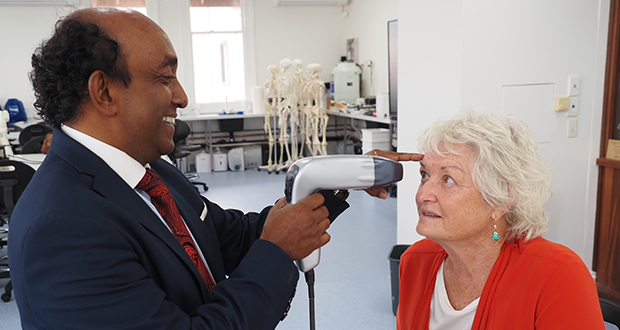A digital eye screening device is in development that could help detect eye diseases earlier to prevent blindness in older people, and may also play a role in predicting cases of Alzheimer’s disease.
Using artificial intelligence (AI), The University of Notre Dame Australia (UNDA) created the device that fits in a small briefcase to replace the current 30kg equipment.
“We’ve developed a low-cost, easy-to-use and non-invasive imaging device for the front and back of the eye in combination with artificial intelligence,” said UNDA chair of Digital Health and Telemedicine, Yogi Kanagasingam.
Diseases such as glaucoma, diabetic retinopathy, cataract or age-related macular degeneration can be treated when identified early, he said.
However, specialist care can be difficult to access in rural and remote areas, making quick detection problematic.
Over half of Australians living remotely reported not having access to a specialist, according to the Australian Institute of Health and Welfare.
Specifically, the rate of ophthalmologists in very remote areas is 4.1 per a population of 100,000.
“There aren’t many ophthalmologists in rural areas,” explains Kanagasingam. “We want to bring specialist eye care to the doorstep of those who are in need.”
“This device can be used by anyone – nurses, medical staff and health care workers. They take the photo and AI will tell them whether the patient has to be sent to the specialist or not for treatment or surgery.”
Chronic eye diseases affect 93 per cent of people aged over 65 years, according to the Australian Institute of Health and Welfare.
It is estimated over 400,000 people have cataracts, a mostly aged-related condition that clouds the lens inside the eye.
While the device has promise for Australian's rural areas, Kanagasingam also wants to help people in India, where 25% of the population is blind and 3 million people suffer because of cataracts.
"It goes by mobile phone so you can take a photo of the eye, just the front of the eye, and the artificial intelligence will tell what the grading is of the cataract. So this is really simple and easy to use by anybody."
Alzheimer’s disease
The smart device might also have a role to play in diagnosing other conditions, such as Alzheimer’s disease (AD) and dementia.
Kanagasingam is currently working with Alzheimer’s WA to collect data of older patients to identify signs of AD.
“You can identify who's going to get Alzheimer's in 10 years’ time,” Kanagasingam says.
A study in which he collaborated found that “while AD pathology occurs primarily in the brain, the disease has also been reported to affect the eye, which is more accessible for imaging than the brain”.
“The findings indicate a relationship between retinal vascular parameters, neocortical plaque load and AD.
“Since neocortical plaque load increases many years before the cognitive symptoms of AD arise, a non-invasive retinal test holds promise as an integral part of a screening test for early detection of AD.”
Do you have an idea for a story?Email [email protected]
 Aged Care Insite Australia's number one aged care news source
Aged Care Insite Australia's number one aged care news source

